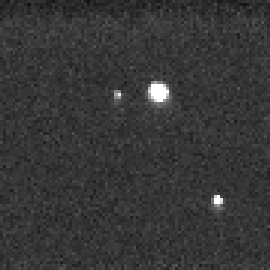Observing conditions were excellent in Brownsville, with photometric skies and subarcsecond seeing. We obtained unfiltered data at 2 Hz on a CCD field which included Triton/Tr176, Neptune, and a reference star. Data cubes were also obtained 1.5 hours prior to the event to permit separate photometry of Triton and Tr176. Thus we have good relative photometry of the event, with immersion half-flux occurring at 10:09:34 UTC and emersion half-flux at 10:11:17 UTC (duration=103 seconds). Our data are of high quality, and the calibrated lightcurve shows residual stellar flux at a level of about 10% in midoccultation. However, no central flash was observed. From our chord length, Olkin (private communication) derives a radius of closest approach of the Brownsville station (latitude 25:58:40.95 +/- 0.10 N, longitude 97:32:11.29 +/- 0.10 W, elev. -0.9 +/- 6.7 m) to Triton of 645 km, using a model Triton atmosphere derived from previous occultation data (Olkin et al., in press). A fit of our data to a model atmosphere calculated by Yelle gives a radius of closest approach of about 605 km, while a fit to the Voyager RSS model gives a result similar to Olkin's. Analysis of our data to obtain temperature and density profiles of Triton's atmosphere in the microbar pressure range is proceeding.
Our team was greatly assisted by Professors Arnulfo Mar and Mario Diaz of the University of Texas at Brownsville. We thank Professor Diaz and his family for allowing us to observe from their residence. The University of Arizona occultation program is supported by NASA Planetary Astronomy Grant NAG5-4214.

15 minute plot of data

Higher resolution, 3 minute plot of data

Data compared to models

The star and Triton are to the left of Neptune (brightest image). There is a bright reference star below and to the right of Neptune. Notice the dimming of the star as Triton's tenuous atmosphere occults it. Triton was 30 AU from Earth (4.5 billion kilometers!).